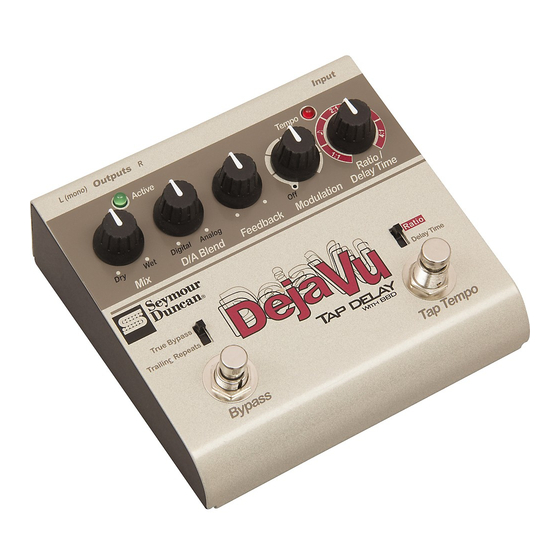Duncan SFX-10 Deja Vu User Manual - Page 12
Browse online or download pdf User Manual for Music Pedal Duncan SFX-10 Deja Vu. Duncan SFX-10 Deja Vu 17 pages. Tap delay w/bbd

Playing with the Wet Out/Loop
By now you've figured out that the SFX-10 Tap Delay w/BBD can do clas-
sic delay beautifully. But it can do more—a lot more. The key to many of
the SFX-10's most unique effects lies in the Wet Out/Loop jack. So what
does this jack do anyway? We're glad you asked . . .
The Wet Out/Loop
The jack uses a TRS (tip/ring/sleeve) jack as an insert point in the delay
tone. The tip is the wet send, and the ring is the return. When used
with a mono cable, it turns this jack into a wet out, and takes the wet
signal away from the main outputs. The L/R jacks now become dry only.
But, when used with an "insert cable" (one TRS to two mono jacks) it
becomes an effects loop for the delayed signal only. Let's examine what
happens with the following processors in the Wet Loop:
Volume Pedal:
If you put a volume pedal in that loop, it now becomes a volume con-
trol on your delays. You can set the Mix knob for the desired amount
of maximum Wet/Dry blend, and the volume pedal will fade the delays
from maximum to off.
Distortion/Overdrive:
Distortion and Overdrive need a healthy signal to make the distortion.
That's why loud pickups produce more distortion in your pedals than
quiet ones. In a delay loop, each delay is quieter than the last. So adding
distortion to your delayed sound will produce less recycled distortion
with each repeat, but the delay will be repeating the previously distorted
sound. It's a good way to add dirtiness to your delays while keeping
your dry signal crisp.
Chorus/Flange/Phaser:
Since these effects are not dependent on volume, each of these modu-
lation effects will become more intense with each repeat, because the
effect on the sound is compounded.
12
